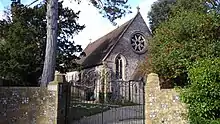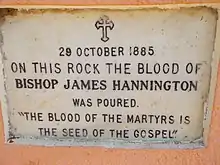James Hannington | |
|---|---|
| former Bishop of Eastern Equatorial Africa | |
 James Hannington | |
| Church | Church of England |
| Diocese | Diocese of Eastern Equatorial Africa |
| Installed | 24 June 1884 |
| Term ended | 29 October 1885 |
| Successor | Henry Parker |
| Personal details | |
| Born | 3 September 1847 |
| Died | 29 October 1885 (aged 38) Busoga, Uganda |
| Sainthood | |
| Feast day | 29 October |
| Venerated in | Anglican Communion |
| Title as Saint | Bishop and Martyr |
| Shrines | Bishop Hannington Memorial Church, Hove |
James Hannington (3 September 1847 – 29 October 1885) was an English Anglican missionary and martyr. He was the first Anglican bishop of East Africa.
Early life
Hannington was born on 3 September 1847 at Hurstpierpoint in Sussex, England, about eight miles from Brighton, where his father ran a warehouse,[1] and was part of the family that ran Hanningtons department stores.[2] His father, Charles Smith Hannington, had recently acquired the property known as St George's. During his childhood, Hannington was a collector[3] and he blew off his thumb with black powder.[4]
For Hannington's early education a tutor had been engaged, but when he was thirteen he was sent to the Temple School at Brighton, where he remained for the next two-and-a-half years, although he was an indifferent student.[3]
Hannington left school at fifteen to work in his father's Brighton counting house. He obtained a commission in the 1st Sussex Artillery Volunteer Corps in 1864[5] and rose to the rank of major.[1] Under his training and supervision, his detachment won prizes at the annual camp competitions.[3]
Ministry

The family were Congregationalists but joined the Church of England in 1867. In that year the chapel which Hannington's father had built in the grounds of his property in 1852 was licensed for Anglican services.[6] At twenty-one, Hannington decided to pursue a clerical career, and entered university at St Mary Hall, Oxford; he was President of the Red Club and captain of the St Mary Hall Boat.[1] In 1872, the death of his mother spurred a change in Hannington's life; he was awarded his BA, and on 1 March 1874 was made a deacon (by Frederick Temple, Bishop of Exeter, at Exeter Cathedral),[7] and took a curacy of Martinhoe with Trentishoe, Devon.[8] Having been ordained priest, in 1875 James became curate-in-charge at St George's, Hurstpierpoint where he stayed until volunteering for missionary work in East Africa in 1882.[4] He had by then been married for five years.
Around 1882, Hannington heard of the murder of two missionaries on the shores of Lake Victoria. This led to him offering himself to the Church Missionary Society (CMS) and he left England on 17 May, setting sail for Zanzibar on 29 June, as the head of a party of six missionaries. Crippled by fever and dysentery, Hannington was forced to return to England in 1883.[9]
On 24 June 1884 (St John the Baptist's Day), having recovered, Hannington was ordained and consecrated a bishop by Edward White Benson, Archbishop of Canterbury, at St Mary-at-Lambeth, to serve the See of Eastern Equatorial Africa,[10] and in January 1885, at age thirty-seven, Hannington again departed for Africa. His diocese included missions of the CMS at the coast and inland in Buganda.[9] While there Hannington collected a number of shells which were described by E. A. Smith in two papers in the Annals and Magazine of Natural History.[1]


After arriving at Freretown, near Mombasa, in Kenya, Hannington determined to pioneer a shorter and healthier highland road to Buganda, using Christian porters and undercutting the Arab slave route to the south. He was oblivious to the political consequences of traversing Busoga, a strategically sensitive area for the Buganda state. The sudden intrusion of German imperialism at the coast made the Kabaka of Buganda Mwanga II, even more suspicious of Hannington's motives.[9] An oracle (emmandwa) had said that Buganda's conqueror would come from the east. Mwanga forbade Hannington from continuing through Busoga and sent boats to take him to Sukumaland, but Hannington refused.[11] Together with his team, he safely reached a spot near Lake Victoria on 21 October, but, under the orders of Mwanga II of Buganda, the missionaries were imprisoned in Busoga by Basoga chiefs.
After eight days of captivity, by order from Mwanga II, Hannington's porters were killed, and on 29 October 1885, Hannington himself was speared in both sides.[4] As he died, his alleged last words to the soldiers who killed him were: "Go, tell Mwanga I have purchased the road to Uganda with my blood."
Alexander Murdoch Mackay, who had first-hand knowledge of events from the Buganda side, in letters dated 2 May 1886, wrote:
"Had the matter of the Busoga route been the real point at issue, the king needed only to adopt our advice at the time, and request the Bishop to return to the neighbourhood of Kwa Sundu in Kavirondo, whither the boat had gone for him. But he was determined on shedding the blood of one whom he believed was a European of higher standing than merely an ordinary missionary or traveler, as 'a challenge to the whole of Europe' as he said himself ... this case was absolutely unprovoked and unjustifiable on any ground, the extent of the crime being much increased by the fact that our brethren were coming after the King's own repeated invitation, although they themselves were, perhaps, not aware of that fact. Further we gave the King perfectly to understand who they were, and why they came via the east, viz., to avoid the Germans"[12]

Widespread persecution of Christians followed, many being killed or sold to Arab slavers.[13] Joseph Mukasa Balikuddembe, a Roman Catholic and an official at Mwanga's court, rebuked the king for the deed, and was beheaded for it. Hannington and his companions were among the first Martyrs of Uganda.
The location of Hannington's remains was divulged to Bishop Alfred Tucker in 1892 and on 31 December 1892, his remains were reburied at Namirembe. He is commemorated by the Hannington memorial chapel in Namirembe Cathedral, Kampala, Uganda.
James Hannington is honored in the Church of England and in the Episcopal Church on 29 October.[14][15] A dedication stone, erected in his memory along with the Bishop Hannington Memorial Church, West Blatchington, Hove, England in 1938, bears the inscription "Thou hast turned my heaviness into joy".
See also
- Anglican Church of Kenya
- Anglican Church of Tanzania
- Church of Uganda
- Bishop of Uganda
- Saints in Anglicanism
- Lake Bogoria (formerly Lake Hannington)
References
Citations
- 1 2 3 4 Verdcourt, Bernard (June 1981). "James Hannington - 1847-1885 - Collectors in East Africa - 3". The Conchologists' Newsletter (77): 317–318. Retrieved 16 May 2019 – via The Conchological Society of Great Britain and Ireland.
- ↑ "Looking back: A store with a special place in Brighton and Hove's history". The Argus. 8 July 2013. Retrieved 16 May 2019.
- 1 2 3 Hansford, F. E. (n.d.). "James Hannington (1847-1885)". Great Churchmen No. 22. Church Book Room Press. Retrieved 16 May 2019 – via Church Society.
- 1 2 3 Graves, Dan (28 April 2010). "James Hannington Captured". Christianity.com. Retrieved 16 May 2019.
- ↑ "No. 22836". The London Gazette. 22 March 1864. p. 1716.
- ↑ "Brief history, St George's, Hurstpierpoint". achurchnearyou.com.
- ↑ "Ordinations on Sunday last". Church Times. No. 580. 6 March 1874. p. 116. ISSN 0009-658X. Retrieved 21 October 2019 – via UK Press Online archives.
- ↑ "Photo of church". geograph.org.uk.
- 1 2 3 Anderson 1999, p. 278.
- ↑ Dawson 1887, p. 310.
- ↑ Muwonge, Godfrey (21 May 2015). "My Two Cents' Worth: Katikkiro Mukasa Was Behind Many "Mwanga II Executions"". BugandaWatch. Retrieved 16 May 2019.
- ↑ Mackay 1970.
- ↑ Quinn 2002.
- ↑ "The Calendar". The Church of England. Retrieved 9 April 2021.
- ↑ Lesser Feasts and Fasts 2018. Church Publishing, Inc. 17 December 2019. ISBN 978-1-64065-235-4.
Sources
- Anderson, Gerald H. (1999). Biographical Dictionary of Christian Missions. Wm. B. Eerdmans. p. 278. ISBN 978-0-8028-4680-8.</ref>
- Dawson, Edwin Collas (1887). James Hannington, D.D., F.L.S., F.R.G.S., First Bishop of Eastern Equatorial Africa: A History of His Life and Work, 1847-1885. Seeley.
- Hamilton, Thomas (1890). . In Stephen, Leslie; Lee, Sidney (eds.). Dictionary of National Biography. Vol. 24. London: Smith, Elder & Co.
- Reason, Joyce (1978) [1955]. Bishop Jim: The story of James Hannington. London: James Clark Company. ISBN 0-7188-2387-7.
- Mackay, J.W.H. (1970). A.M. Mackay: Pioneer Missionary of the Church Missionary Society Uganda. Routledge. doi:10.4324/9780203770597. ISBN 9780203770597.
- Michael, Charles D. (1910). James Hannington, bishop and martyr: the story of a noble life. London: S.W. Partridge.
- Quinn, Frederick (2002). African Saints: Saints, Martyrs, and Holy People from the Continent of Africa. Crossroad. ISBN 978-0-8245-1971-1.
